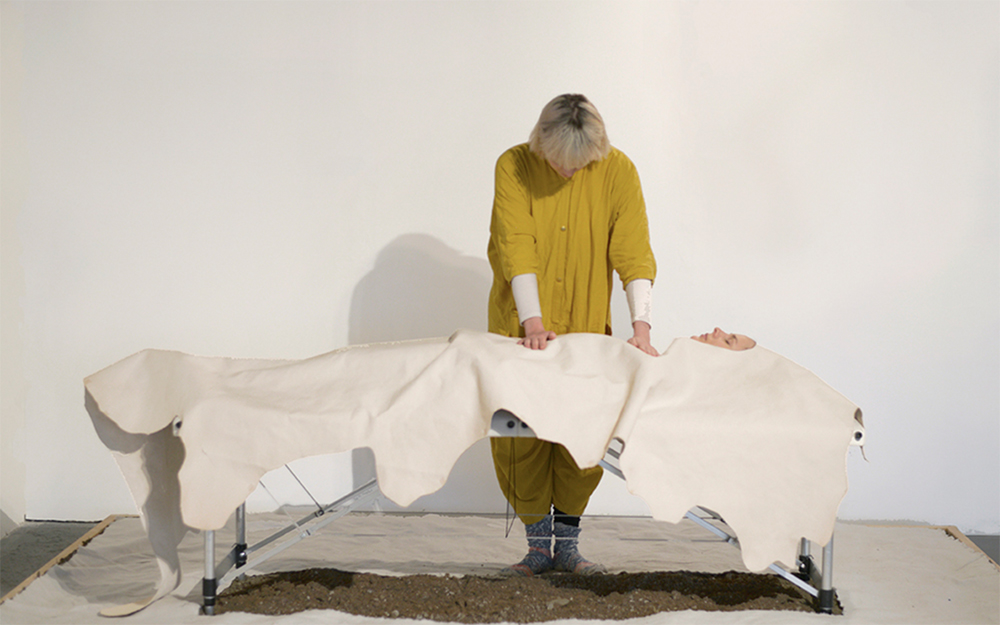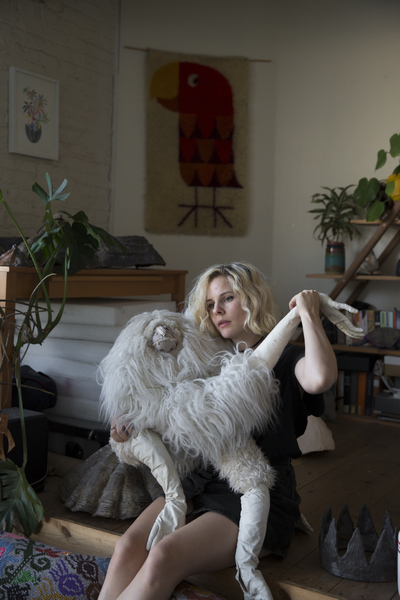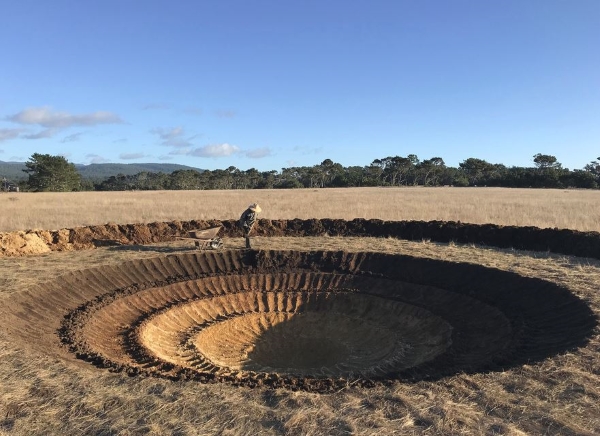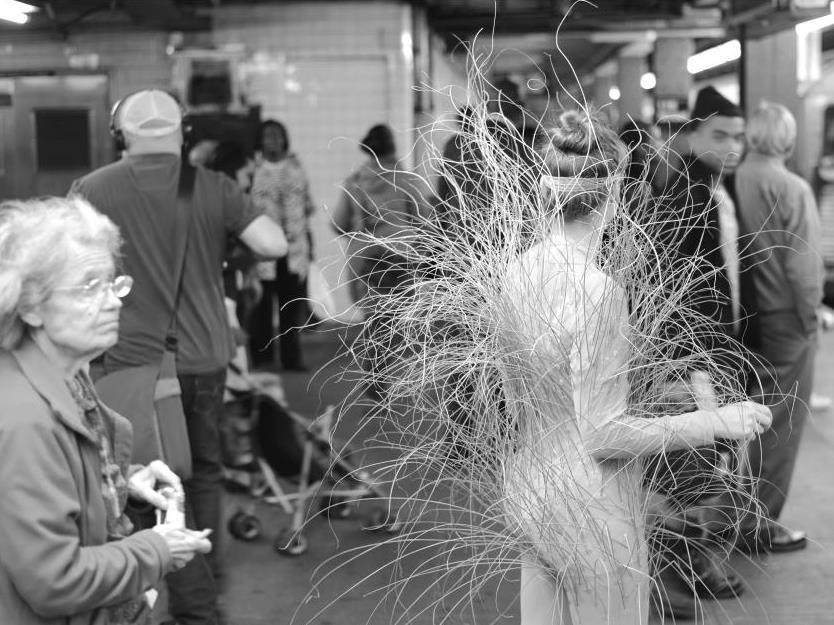Jemila MacEwan, Maiden Grass Voyage, 2013. Image: Campbell Watson
If you’ve ever visited New York, you know that its energy is palpable, and unrivalled by many other major cities in the world. It’s an epicentre for both established and aspiring artists, but how easy is it to survive in this world as an outsider? In this short series, we profile Australian creatives who tell us how they survived.
Part 1: Jemila MacEwan – Interdisciplinary Artist
Jemila MacEwan moved to New York from Melbourne six years ago with her partner and is currently based in Brooklyn. Her practice involves painting, sculpture, video installation and performance.
‘Anything that you say about this city, you’ll find the opposite,’ MacEwan told ArtsHub. ‘You’ll find the really aggressive, cut-throat bitchy, horrible people and you’ll also find incredibly tender, soft, gentle, spiritual people. It has all of these personalities and types.
‘What I think I notice is that whatever your type is, you’re totally in it and there’s no pretending to be anyone else because no one’s interested in that. People are really interested in who you are. I feel really seen here.’

Jemila MacEwan’s A taming, 2018. Performance with leather hide, massage table, soil, and cotton fabric. Image: Campbell Watson
On Performance
For her first street performance in New York MacEwan made a six-hour north-south transect of Manhattan by foot and rail, wearing a fine mesh bodysuit from which blades of maiden grass extended; the grass acting as a conduit for touch, conducting vibrations to and from MacEwan’s body, filling the space between her and her environment.
‘MaidenGrass Voyage was a response to my adapting, and trying to come to terms with what this place was as opposed to what Australia was, and that was a really difficult conflict,’ she said.
‘Melbourne, for one, is such a green, lush and calming city in a way that I think I took for granted – like being able to touch and smell plants all the time. Manhattan is touch-phobic, everything is dirty, everything smells and people don’t want to touch each other. So I was like, “How can I know this city through touch?” because I realised that was how I get intimate with the place.
‘Every neighbourhood I went into the interactions were different. The questions were different, the answers were different, I changed. Then it set the tone for all of my performance work after that.’
On arts funding in New York
After the first ‘brutally hard’ year in New York, MacEwan planned to go back home, but as fate would have it, an Australian election resulted in such massive funding cuts to the arts that her future there held no promise.
‘The possibility for both of us [her and her partner] just looked so bleak, and it was really the point where I realised how contingent Australian government funding was to both of our careers. In the US a massive portion of funding and opportunities for the arts and for science is actually philanthropically run and it’s because there’s a huge amount of corporate wealth here and diversity. You don’t just have a couple of companies, you have billions, It’s one of the ways that we can survive.’

Jemila MacEwan. Image: Katharina Poblotzki
On approaching ideas
‘People here have a lot of big ideas. Sometimes in Australia, I think people will often dial down an idea that’s quite ambitious. There’s a perfectionism or conservatism around putting yourself out there in a messy way.
‘If you tell someone here a small idea, at best, they’ll be like casually interested. If you tell someone a ridiculously big, ambitious idea that seems almost un-do-able to you, they’ll be like: “that’s brilliant, you should do it.” And then they’ll help you do it; your imagining keeps getting bigger.
‘There’s so many opportunities here that you’re competing for, especially as an artist, you’re continuously applying for things – you see who gets it and you see what they make and you go: “Oh, I need to be thinking a bit bigger, because that’s what’s going to get rewarded.”‘

Human Meteorite, 2017. Image: Campbell Watson
On building a community
‘It’s a completely different way of operating over here. If you go looking for the Artist Run Spaces to try and exhibit work, they don’t exist really. So you’re like, “What is there”? So much of it is really community based and that is something that takes such a long time to build.
‘If you’re moving here as an artist I would suggest looking up institutions like New York Foundation for the Arts (NYFA), Creative Capital or Lower Manhattan Cultural Council; these long-term residencies whose aims are not necessarily about building career but they are about building community. Also, Flux Factory, Triangle Arts Association or Trestle, there are a few different ones like that, but I think there are many institutions here who help to support you.’
On Residencies
‘The best medium of support I found for my practice has not been through grants in recent years, it’s been through residencies.
‘I had a few opportunities that became really significant in helping me grow roots here. One of them was the Flux Factory Residency, which I always recommend to artists who are moving here because it’s like an instant community of really dedicated, interesting diverse artists who are working in this experimental way. You get to work on everyone’s projects and they run all these events. As a residency it’s a place that I also keep returning to because they do so many events you can participate, and also meet all of the new residents, and that becomes something that keeps giving to you if you stay here.”
On Visas
‘The exploitation for people from overseas can be very real. If you can be independent, if you can get an O Visa [Individuals with extraordinary ability or achievement] it’s better than an E Visa, they’re more expensive to get but they do give you the freedom.
‘Before we moved here we got married so we wouldn’t have to juggle two visas the whole time. A lot of people do get married as a way to deal with visas. Especially to get an O Visa, it’s a huge amount of work and it tests all of your resources because you have to be asking for letters of reference from everyone and there’s really no guarantee.’
On Patience
‘Things can happen slowly and spontaneously here. On one hand you have to be extraordinarily patient and then on the other hand you have to be very quick to respond. Some opportunities are given to you and you have to make them in a month and others it’s like the slowest dance ever. And people can be really paying attention to you but holding their cards. There’s part of you that has to be, like, not paranoid, but paying attention to who’s paying attention.
‘My first job that I had here was working for a high-end small scale designer as her master leather artisan. And it was physically brutal work, because we didn’t use any machines, everything was handmade to order. It was exhausting, my body was so crippled and in order to sleep every night I would have to get a massage.
‘But in a way that job also grew me a great deal. It really taught me patience and focus and the art of it was so zen and so refined that I do think that job made me a better artist, even though it wasn’t art.’





